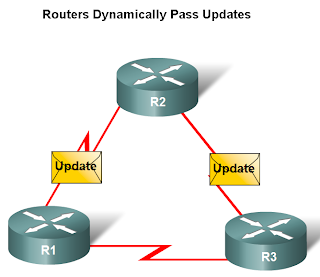Objectives
-Automatically update routing table when topology changes.
-Determine best path to a destination.
-Maintaining up-to-date routing information
-Choosing the best path to destination networks
-Ability to find a new best path if the current path is no longer available
Components of a routing protocol:
- Describe the role of dynamic routing protocols and place these protocols in the context of modern network design.
- Identify several ways to classify routing protocols.
- Describe how metrics are used by routing protocols and identify the metric types used by dynamic routing protocols.
- Determine the administrative distance of a route and describe its importance in the routing process.
- Identify the different elements of the routing table.
Function(s) of Dynamic Routing Protocols:
-Dynamically share information between routers.-Automatically update routing table when topology changes.
-Determine best path to a destination.
The purpose of a dynamic routing protocol is to:
-Discover remote networks-Maintaining up-to-date routing information
-Choosing the best path to destination networks
-Ability to find a new best path if the current path is no longer available
Components of a routing protocol:
- Algorithm
In the case of a routing protocol algorithms are used for facilitating routing information and best path determination
- Routing protocol messages
These are messages for discovering neighbors and exchange of routing information
Next, please download the links Below


















0 comments:
Post a Comment